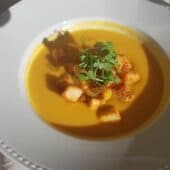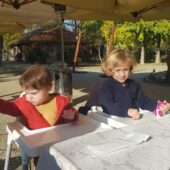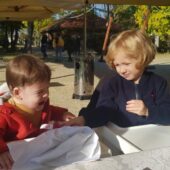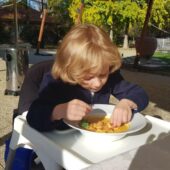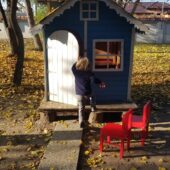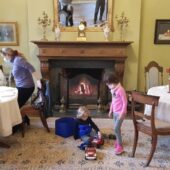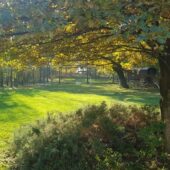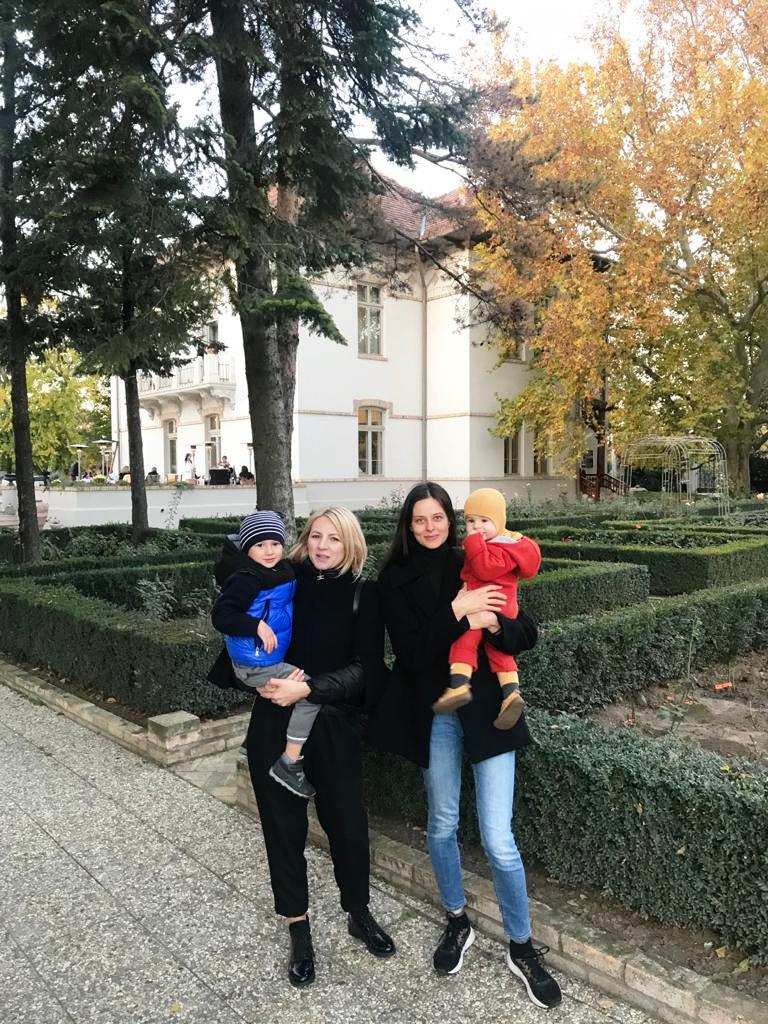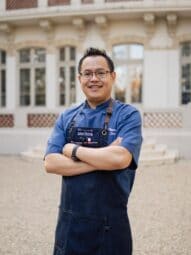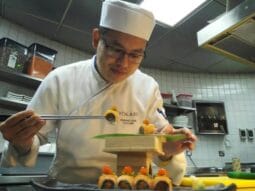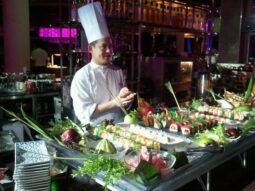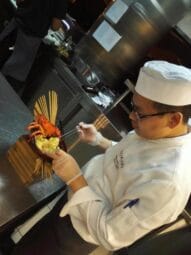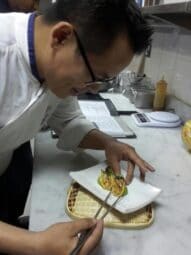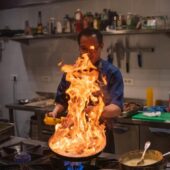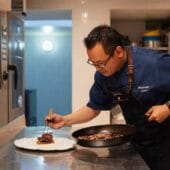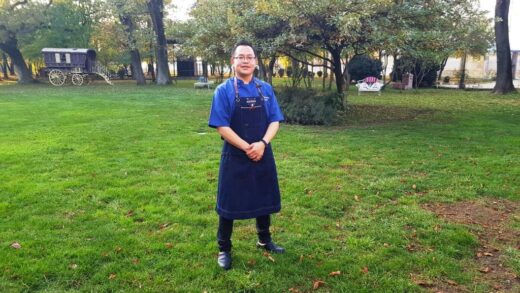Așadar, „Vă invităm la una dintre cele mai apreciate experiențe de dining ale toamnei: Autour de la truffe – ediția a V-a, ce va avea loc duminică. La fel ca în fiecare an, vă așteptăm cu un meniu din 4 piese, fiecare preparat fiind înnobilat de aroma distinctă a acestui ingredient prețios, trufe culese din pădurile Bucovinei, de la altitudini de 600-800 metri.”
Nu m-au mai prins pe picior greșit cei de la Domeniul Manasia, ca altă dată. Știam că va fi vorba despre ceva sofisticat încă înainte de a fi citit textul care începea cu un „Invitație” bolduit și frumos colorat. Da, îmi aduc mereu aminte că atunci când am primit primul text cu „invitație” de la ei, acum un an de zile, auzisem doar de conacul de la Domeniul Manasia, însă nu știam mai mult decât atât. Mă așteptasem să ajung la un căsoi de țară printre câțiva copaci oricum rari în Câmpia Bărăganului, și m-am trezit în luxul aristocratic citadin al unui mic palat plin cu opere de artă de galerie europeană. Mă uitam după o curte cu mese și scaune făcute din bușteni întregi și am văzut un parc londonez cu sculpturi în metal și alei ca în filmele franțuzești de epocă. Și în locul sarmalelor, cârnaților și țuicii, am avut în farfurie bucătărie fină cu și șampanie franțuzească.
Dar tot nu am rămas nesurprins, așa cum mă pregătisem. Mă așteptam să ne gătească un chef de înaltă clasă, ca de fiecare dată, insa acum l-am găsit la Manasia chiar pe Phursang Lama! Și nu ca chef invitat, ci chiar head cheful rezident al Domeniului, pregătit să rămână multă vreme în acel decor de film.
Tânărul Phursang Lama e un mare chef, am scris despre el cu risipă de epitete încă de când am mâncat prima dată la Ginger, sofisticatul restaurant asiatic al bucureșteanului Radisson Blue Hotel. Am avut multe cineacolo, au primit și premii de la noi pentru restaurantul lor, în special pentru sushi și sashimi.
Cu știința lui in ale noii bucătării asiatice contemporane, în special, dar și ale bucătăriei fine, în general, Phursang Lama ar putea să-și aleagă orice țară ar vrea ca să lucreze și să trăiască acolo, fiindcă orice restaurant mare din lume l-ar primi cu brațele deschise. Însă el, asiatica lui femeie și cei doi asiatici și mici copii au prins cu toții drag de România, așa că au rămas aici după ce virusul i-a obligat pe cei de la Radisson să-și inchidă toate restaurantele.
Nu am mâncat ca asiaticii la Domeniul Manasia, de această dată, ci un meniu fin franțuzesc: Duo de pește cu trufe, Scoici Saint Jacques cu trufe, Mușchi de vită argentinian cu trufe și Mille-feuille cu cremă de vanilie aromată cu trufe și smochine. Cu vinuri la fel de fine, dar la care eu m-am uitat doar cu mare jind, nefiind încă atât de bogat încât sa mă aștepte un șofer cu tunică albastră și cu caschetă în mașină. O conduc singur, pentru moment.
Și da, odată cu venirea noului bucătar, s-a globalizat și ultimul ungher din Domeniul Manasia: ascendență nobiliară daneză, bulgărească și sârbească, lux occidental, mare chef asiatic, musafiri din toată lumea… (GB – noiembrie 2020)
Meniul cu trufe al lui Chef Phursang Lama
Domnișori și domnișosre la…
… Domeniul Manasia
My Name is PHURSANG LAMA and I was born in Nepal with Lama (Buddies monk) family. And I did not became a monk because my father was in the Nepalese army, where he served the nation for 30 years. After my high school, I worked as a cook’s assistant in Thamel, a popular tourist destination of Kathmandu Nepal, in a Japanese café. It was then when I realized that’s what I wanted, and then I joined the Kathmandu culinary diploma school at Shangri-la tourist & hotel training centers.
My journey as a chef began more than 13 years ago in different international hospitality industry sites. My first job was at “The station pup & cafe”, as a kitchen helper, in 2004. After this job I decided to do my own local business at Kathmandu, where I kept my business till 2007. I got the chance to work as a pre-opening team commis III at Amwaj Rotana Resort Jumeirah Beach for a year, which is the best hotel chain in The Middle East. After another year I moved to a different property of the same group, namely Al Ain Rotana Hotel, as a commis II in the best all day dinning restaurant from 2009 to 2010.
I joined Intercontinental hotel Abu Dhabi as a Japanese cook since in 2010, stayed there by 2012. Here I had the chance to work with many celebrity chefs, like the Japanese celebrity chef Hal Yamashita and the Thai celebrity chef Iankittichai. Then I move to Grand Millennium Al Wanda Abu Dhabi in 2012, as a chef de partie with the Asian restaurant Toshi, which was shortlisted top 5 Japanese restaurants by the Time Out Awards Abu Dhabi. I got a new challenge again, to open a new restaurant in Abu Dhabi, Sushi Maru Japanese Restaurant, working there as the head chef until 2015.
A great opportunity arises when Yokari Fine Dining Japanese Restaurant, a contemporary Japanese cuisine famous restaurant, invited me to join as a sous-chef. Remained there until the 8th of September 2017, when I came to Romania to take the Asian Chef de Cuisine role and open the Ginger Restaurant with the Radisson Blue Hotel in Bucharest. Until the pandemic closed it, in July 2020…
My story turns to love about my new country. Naturally beautiful, cultured, with friendly people and a cuisine which definitely conquered me. That is why I considered myself lucky when I got a call from The “Domeniul Manasia”! Now I am it’s head chef and feel great!
To become a Chef is not necessarily a matter of time. It takes passion, patience and love in this job. And we have to experience the chaos of the kitchen for many years before becoming a real chef. There are a lot of different ingredients for different dishes in different cuisines, but my main ingredient in the plate is where I put my love. According to my culture and religion, Love Is a pure feeling that you give unselfishly to another living being. It comes with a total feeling of comfort, knowing that you haven’t caused suffering to anyone. Instead, you have helped bring them joyful and wish.
The main „secrets” in food are freshness, quantity of the products and ingredients used for dishes and how you handle the receipt. But besides being tasty, it’s packed with healthy benefits. I use in my kitchen tuna belly (otoro/ chotoro), fresh salmon for sashimi and hamachi (yellowtail) and yuzu juice which helps to reduce omega -6, cholesterol, prevents heart attacks, blood circulation and it is full of neutral omega-3, potassium and saturated booster.
My roots from the Asian culture made me understand that we want everything to be a perfect well thought out and meaningful. This is also reflected in our food. Food is a cultural feature of the people. Rice and seafood are very important in everyday Asian life. The evolution of the culture was directly reflected on our cuisines. And I have to mention that fish is part of the Japanese diet, for example. Whether it is eaten almost alive (odorgui-still dancing), raw (nama or shasimi), grilled (yaki) or fried (tempura), it seems that the Japanese have tried almost all possible methods.
And a few words about my soul… What is the meaning of „Lama” and what we should do to became “Lama”? LAMA is the Tibetan word which refers to Higher Priest or Spirituals teacher. The “LAMA” doesn’t stand for a name or cast, it is a principle, namely the highest. In ancient times, lama refers to highest venerable spiritual master, but nowadays it is used as an honorific title for a Buddhist monk and nuns.
There are three kinds of path so called YANA in Buddhism: Hina yana, Maha Yana and Bajra Yana. Hina yana stands for small vehicle, Maha yana stands for great vehicle, and Bajra yana stands for secret vehicle through which we can travel from this place to another place. But we can find Lama in two Yana or vehicles only, in Maha yana or Bajra Yana, but in Hina yana, one calls Lama as vante, like that! To become a “LAMA”, we should tack a vow from profound spiritual teacher, and follow the path which shown by Buddha and our Teacher.
Chef Phursang Lama antrenându-se la marile restaurante din Asia sa natală…
… pentru a deveni Head Chef la Domeniul Manasia.













